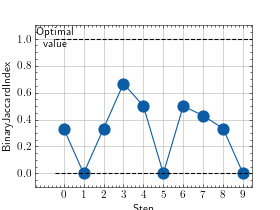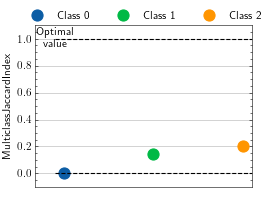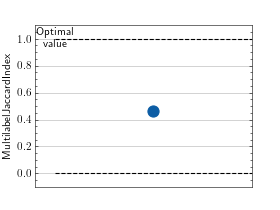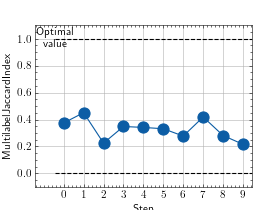Jaccard Index¶
Module Interface¶
- class torchmetrics.JaccardIndex(**kwargs)[source]¶
Calculate the Jaccard index for multilabel tasks.
The Jaccard index (also known as the intersection over union or jaccard similarity coefficient) is an statistic that can be used to determine the similarity and diversity of a sample set. It is defined as the size of the intersection divided by the union of the sample sets:
\[J(A,B) = \frac{|A\cap B|}{|A\cup B|}\]This function is a simple wrapper to get the task specific versions of this metric, which is done by setting the
taskargument to either'binary','multiclass'or'multilabel'. See the documentation ofBinaryJaccardIndex,MulticlassJaccardIndexandMultilabelJaccardIndexfor the specific details of each argument influence and examples.- Legacy Example:
>>> from torch import randint, tensor >>> target = randint(0, 2, (10, 25, 25)) >>> pred = tensor(target) >>> pred[2:5, 7:13, 9:15] = 1 - pred[2:5, 7:13, 9:15] >>> jaccard = JaccardIndex(task="multiclass", num_classes=2) >>> jaccard(pred, target) tensor(0.9660)
BinaryJaccardIndex¶
- class torchmetrics.classification.BinaryJaccardIndex(threshold=0.5, ignore_index=None, validate_args=True, zero_division=0, **kwargs)[source]¶
Calculate the Jaccard index for binary tasks.
The Jaccard index (also known as the intersection over union or jaccard similarity coefficient) is an statistic that can be used to determine the similarity and diversity of a sample set. It is defined as the size of the intersection divided by the union of the sample sets:
\[J(A,B) = \frac{|A\cap B|}{|A\cup B|}\]As input to
forwardandupdatethe metric accepts the following input:preds(Tensor): A int or float tensor of shape(N, ...). If preds is a floating point tensor with values outside [0,1] range we consider the input to be logits and will auto apply sigmoid per element. Additionally, we convert to int tensor with thresholding using the value inthreshold.target(Tensor): An int tensor of shape(N, ...).
Tip
Additional dimension
...will be flattened into the batch dimension.As output to
forwardandcomputethe metric returns the following output:bji(Tensor): A tensor containing the Binary Jaccard Index.
- Parameters:
threshold¶ (
float) – Threshold for transforming probability to binary (0,1) predictionsignore_index¶ (
Optional[int]) – Specifies a target value that is ignored and does not contribute to the metric calculationvalidate_args¶ (
bool) – bool indicating if input arguments and tensors should be validated for correctness. Set toFalsefor faster computations.zero_division¶ (
float) – Value to replace when there is a division by zero. Should be 0 or 1.kwargs¶ (
Any) – Additional keyword arguments, see Advanced metric settings for more info.
- Example (preds is int tensor):
>>> from torch import tensor >>> from torchmetrics.classification import BinaryJaccardIndex >>> target = tensor([1, 1, 0, 0]) >>> preds = tensor([0, 1, 0, 0]) >>> metric = BinaryJaccardIndex() >>> metric(preds, target) tensor(0.5000)
- Example (preds is float tensor):
>>> from torchmetrics.classification import BinaryJaccardIndex >>> target = tensor([1, 1, 0, 0]) >>> preds = tensor([0.35, 0.85, 0.48, 0.01]) >>> metric = BinaryJaccardIndex() >>> metric(preds, target) tensor(0.5000)
- plot(val=None, ax=None)[source]¶
Plot a single or multiple values from the metric.
- Parameters:
val¶ (
Union[Tensor,Sequence[Tensor],None]) – Either a single result from calling metric.forward or metric.compute or a list of these results. If no value is provided, will automatically call metric.compute and plot that result.ax¶ (
Optional[Axes]) – An matplotlib axis object. If provided will add plot to that axis
- Return type:
- Returns:
Figure object and Axes object
- Raises:
ModuleNotFoundError – If matplotlib is not installed
>>> # Example plotting a single value >>> from torch import rand, randint >>> from torchmetrics.classification import BinaryJaccardIndex >>> metric = BinaryJaccardIndex() >>> metric.update(rand(10), randint(2,(10,))) >>> fig_, ax_ = metric.plot()

>>> # Example plotting multiple values >>> from torch import rand, randint >>> from torchmetrics.classification import BinaryJaccardIndex >>> metric = BinaryJaccardIndex() >>> values = [ ] >>> for _ in range(10): ... values.append(metric(rand(10), randint(2,(10,)))) >>> fig_, ax_ = metric.plot(values)

MulticlassJaccardIndex¶
- class torchmetrics.classification.MulticlassJaccardIndex(num_classes, average='macro', ignore_index=None, validate_args=True, zero_division=0, **kwargs)[source]¶
Calculate the Jaccard index for multiclass tasks.
The Jaccard index (also known as the intersection over union or jaccard similarity coefficient) is an statistic that can be used to determine the similarity and diversity of a sample set. It is defined as the size of the intersection divided by the union of the sample sets:
\[J(A,B) = \frac{|A\cap B|}{|A\cup B|}\]As input to
forwardandupdatethe metric accepts the following input:preds(Tensor): A int tensor of shape(N, ...)or float tensor of shape(N, C, ..). If preds is a floating point we applytorch.argmaxalong theCdimension to automatically convert probabilities/logits into an int tensor.target(Tensor): An int tensor of shape(N, ...).
Tip
Additional dimension
...will be flattened into the batch dimension.As output to
forwardandcomputethe metric returns the following output:mcji(Tensor): A tensor containing the Multi-class Jaccard Index.
- Parameters:
num_classes¶ (
int) – Integer specifying the number of classesignore_index¶ (
Optional[int]) – Specifies a target value that is ignored and does not contribute to the metric calculationaverage¶ (
Optional[Literal['micro','macro','weighted','none']]) –Defines the reduction that is applied over labels. Should be one of the following:
micro: Sum statistics over all labelsmacro: Calculate statistics for each label and average themweighted: calculates statistics for each label and computes weighted average using their support"none"orNone: calculates statistic for each label and applies no reduction
validate_args¶ (
bool) – bool indicating if input arguments and tensors should be validated for correctness. Set toFalsefor faster computations.zero_division¶ (
float) – Value to replace when there is a division by zero. Should be 0 or 1.kwargs¶ (
Any) – Additional keyword arguments, see Advanced metric settings for more info.
- Example (pred is integer tensor):
>>> from torch import tensor >>> from torchmetrics.classification import MulticlassJaccardIndex >>> target = tensor([2, 1, 0, 0]) >>> preds = tensor([2, 1, 0, 1]) >>> metric = MulticlassJaccardIndex(num_classes=3) >>> metric(preds, target) tensor(0.6667)
- Example (pred is float tensor):
>>> from torchmetrics.classification import MulticlassJaccardIndex >>> target = tensor([2, 1, 0, 0]) >>> preds = tensor([[0.16, 0.26, 0.58], ... [0.22, 0.61, 0.17], ... [0.71, 0.09, 0.20], ... [0.05, 0.82, 0.13]]) >>> metric = MulticlassJaccardIndex(num_classes=3) >>> metric(preds, target) tensor(0.6667)
- plot(val=None, ax=None)[source]¶
Plot a single or multiple values from the metric.
- Parameters:
val¶ (
Union[Tensor,Sequence[Tensor],None]) – Either a single result from calling metric.forward or metric.compute or a list of these results. If no value is provided, will automatically call metric.compute and plot that result.ax¶ (
Optional[Axes]) – An matplotlib axis object. If provided will add plot to that axis
- Return type:
- Returns:
Figure object and Axes object
- Raises:
ModuleNotFoundError – If matplotlib is not installed
>>> # Example plotting a single value per class >>> from torch import randint >>> from torchmetrics.classification import MulticlassJaccardIndex >>> metric = MulticlassJaccardIndex(num_classes=3, average=None) >>> metric.update(randint(3, (20,)), randint(3, (20,))) >>> fig_, ax_ = metric.plot()

>>> # Example plotting a multiple values per class >>> from torch import randint >>> from torchmetrics.classification import MulticlassJaccardIndex >>> metric = MulticlassJaccardIndex(num_classes=3, average=None) >>> values = [] >>> for _ in range(20): ... values.append(metric(randint(3, (20,)), randint(3, (20,)))) >>> fig_, ax_ = metric.plot(values)

MultilabelJaccardIndex¶
- class torchmetrics.classification.MultilabelJaccardIndex(num_labels, threshold=0.5, average='macro', ignore_index=None, validate_args=True, zero_division=0, **kwargs)[source]¶
Calculate the Jaccard index for multilabel tasks.
The Jaccard index (also known as the intersection over union or jaccard similarity coefficient) is an statistic that can be used to determine the similarity and diversity of a sample set. It is defined as the size of the intersection divided by the union of the sample sets:
\[J(A,B) = \frac{|A\cap B|}{|A\cup B|}\]As input to
forwardandupdatethe metric accepts the following input:preds(Tensor): A int tensor or float tensor of shape(N, C, ...). If preds is a floating point tensor with values outside [0,1] range we consider the input to be logits and will auto apply sigmoid per element. Additionally, we convert to int tensor with thresholding using the value inthreshold.target(Tensor): An int tensor of shape(N, C, ...)
Tip
Additional dimension
...will be flattened into the batch dimension.As output to
forwardandcomputethe metric returns the following output:mlji(Tensor): A tensor containing the Multi-label Jaccard Index loss.
- Parameters:
num_classes¶ – Integer specifying the number of labels
threshold¶ (
float) – Threshold for transforming probability to binary (0,1) predictionsignore_index¶ (
Optional[int]) – Specifies a target value that is ignored and does not contribute to the metric calculationaverage¶ (
Optional[Literal['micro','macro','weighted','none']]) –Defines the reduction that is applied over labels. Should be one of the following:
micro: Sum statistics over all labelsmacro: Calculate statistics for each label and average themweighted: calculates statistics for each label and computes weighted average using their support"none"orNone: calculates statistic for each label and applies no reduction
validate_args¶ (
bool) – bool indicating if input arguments and tensors should be validated for correctness. Set toFalsefor faster computations.zero_division¶ (
float) – Value to replace when there is a division by zero. Should be 0 or 1.kwargs¶ (
Any) – Additional keyword arguments, see Advanced metric settings for more info.
- Example (preds is int tensor):
>>> from torch import tensor >>> from torchmetrics.classification import MultilabelJaccardIndex >>> target = tensor([[0, 1, 0], [1, 0, 1]]) >>> preds = tensor([[0, 0, 1], [1, 0, 1]]) >>> metric = MultilabelJaccardIndex(num_labels=3) >>> metric(preds, target) tensor(0.5000)
- Example (preds is float tensor):
>>> from torchmetrics.classification import MultilabelJaccardIndex >>> target = tensor([[0, 1, 0], [1, 0, 1]]) >>> preds = tensor([[0.11, 0.22, 0.84], [0.73, 0.33, 0.92]]) >>> metric = MultilabelJaccardIndex(num_labels=3) >>> metric(preds, target) tensor(0.5000)
- plot(val=None, ax=None)[source]¶
Plot a single or multiple values from the metric.
- Parameters:
val¶ (
Union[Tensor,Sequence[Tensor],None]) – Either a single result from calling metric.forward or metric.compute or a list of these results. If no value is provided, will automatically call metric.compute and plot that result.ax¶ (
Optional[Axes]) – An matplotlib axis object. If provided will add plot to that axis
- Return type:
- Returns:
Figure and Axes object
- Raises:
ModuleNotFoundError – If matplotlib is not installed
>>> # Example plotting a single value >>> from torch import rand, randint >>> from torchmetrics.classification import MultilabelJaccardIndex >>> metric = MultilabelJaccardIndex(num_labels=3) >>> metric.update(randint(2, (20, 3)), randint(2, (20, 3))) >>> fig_, ax_ = metric.plot()

>>> # Example plotting multiple values >>> from torch import rand, randint >>> from torchmetrics.classification import MultilabelJaccardIndex >>> metric = MultilabelJaccardIndex(num_labels=3) >>> values = [ ] >>> for _ in range(10): ... values.append(metric(randint(2, (20, 3)), randint(2, (20, 3)))) >>> fig_, ax_ = metric.plot(values)

Functional Interface¶
jaccard_index¶
- torchmetrics.functional.jaccard_index(preds, target, task, threshold=0.5, num_classes=None, num_labels=None, average='macro', ignore_index=None, validate_args=True, zero_division=0.0)[source]¶
Calculate the Jaccard index.
The Jaccard index (also known as the intersection over union or jaccard similarity coefficient) is an statistic that can be used to determine the similarity and diversity of a sample set. It is defined as the size of the intersection divided by the union of the sample sets: :rtype:
Tensor\[J(A,B) = \frac{|A\cap B|}{|A\cup B|}\]This function is a simple wrapper to get the task specific versions of this metric, which is done by setting the
taskargument to either'binary','multiclass'or'multilabel'. See the documentation ofbinary_jaccard_index(),multiclass_jaccard_index()andmultilabel_jaccard_index()for the specific details of each argument influence and examples.- Legacy Example:
>>> from torch import randint, tensor >>> target = randint(0, 2, (10, 25, 25)) >>> pred = tensor(target) >>> pred[2:5, 7:13, 9:15] = 1 - pred[2:5, 7:13, 9:15] >>> jaccard_index(pred, target, task="multiclass", num_classes=2) tensor(0.9660)
binary_jaccard_index¶
- torchmetrics.functional.classification.binary_jaccard_index(preds, target, threshold=0.5, ignore_index=None, validate_args=True, zero_division=0.0)[source]¶
Calculate the Jaccard index for binary tasks.
The Jaccard index (also known as the intersection over union or jaccard similarity coefficient) is an statistic that can be used to determine the similarity and diversity of a sample set. It is defined as the size of the intersection divided by the union of the sample sets:
\[J(A,B) = \frac{|A\cap B|}{|A\cup B|}\]Accepts the following input tensors:
preds(int or float tensor):(N, ...). If preds is a floating point tensor with values outside [0,1] range we consider the input to be logits and will auto apply sigmoid per element. Additionally, we convert to int tensor with thresholding using the value inthreshold.target(int tensor):(N, ...)
Additional dimension
...will be flattened into the batch dimension.- Parameters:
threshold¶ (
float) – Threshold for transforming probability to binary (0,1) predictionsignore_index¶ (
Optional[int]) – Specifies a target value that is ignored and does not contribute to the metric calculationvalidate_args¶ (
bool) – bool indicating if input arguments and tensors should be validated for correctness. Set toFalsefor faster computations.zero_division¶ (
float) – Value to replace when there is a division by zero. Should be 0 or 1.
- Return type:
- Example (preds is int tensor):
>>> from torch import tensor >>> from torchmetrics.functional.classification import binary_jaccard_index >>> target = tensor([1, 1, 0, 0]) >>> preds = tensor([0, 1, 0, 0]) >>> binary_jaccard_index(preds, target) tensor(0.5000)
- Example (preds is float tensor):
>>> from torchmetrics.functional.classification import binary_jaccard_index >>> target = tensor([1, 1, 0, 0]) >>> preds = tensor([0.35, 0.85, 0.48, 0.01]) >>> binary_jaccard_index(preds, target) tensor(0.5000)
multiclass_jaccard_index¶
- torchmetrics.functional.classification.multiclass_jaccard_index(preds, target, num_classes, average='macro', ignore_index=None, validate_args=True, zero_division=0.0)[source]¶
Calculate the Jaccard index for multiclass tasks.
The Jaccard index (also known as the intersection over union or jaccard similarity coefficient) is an statistic that can be used to determine the similarity and diversity of a sample set. It is defined as the size of the intersection divided by the union of the sample sets:
\[J(A,B) = \frac{|A\cap B|}{|A\cup B|}\]Accepts the following input tensors:
preds:(N, ...)(int tensor) or(N, C, ..)(float tensor). If preds is a floating point we applytorch.argmaxalong theCdimension to automatically convert probabilities/logits into an int tensor.target(int tensor):(N, ...)
Additional dimension
...will be flattened into the batch dimension.- Parameters:
num_classes¶ (
int) – Integer specifying the number of classesaverage¶ (
Optional[Literal['micro','macro','weighted','none']]) –Defines the reduction that is applied over labels. Should be one of the following:
micro: Sum statistics over all labelsmacro: Calculate statistics for each label and average themweighted: calculates statistics for each label and computes weighted average using their support"none"orNone: calculates statistic for each label and applies no reduction
ignore_index¶ (
Optional[int]) – Specifies a target value that is ignored and does not contribute to the metric calculationvalidate_args¶ (
bool) – bool indicating if input arguments and tensors should be validated for correctness. Set toFalsefor faster computations.zero_division¶ (
float) – Value to replace when there is a division by zero. Should be 0 or 1.
- Return type:
- Example (pred is integer tensor):
>>> from torch import tensor >>> from torchmetrics.functional.classification import multiclass_jaccard_index >>> target = tensor([2, 1, 0, 0]) >>> preds = tensor([2, 1, 0, 1]) >>> multiclass_jaccard_index(preds, target, num_classes=3) tensor(0.6667)
- Example (pred is float tensor):
>>> from torchmetrics.functional.classification import multiclass_jaccard_index >>> target = tensor([2, 1, 0, 0]) >>> preds = tensor([[0.16, 0.26, 0.58], ... [0.22, 0.61, 0.17], ... [0.71, 0.09, 0.20], ... [0.05, 0.82, 0.13]]) >>> multiclass_jaccard_index(preds, target, num_classes=3) tensor(0.6667)
multilabel_jaccard_index¶
- torchmetrics.functional.classification.multilabel_jaccard_index(preds, target, num_labels, threshold=0.5, average='macro', ignore_index=None, validate_args=True, zero_division=0.0)[source]¶
Calculate the Jaccard index for multilabel tasks.
The Jaccard index (also known as the intersection over union or jaccard similarity coefficient) is an statistic that can be used to determine the similarity and diversity of a sample set. It is defined as the size of the intersection divided by the union of the sample sets:
\[J(A,B) = \frac{|A\cap B|}{|A\cup B|}\]Accepts the following input tensors:
preds(int or float tensor):(N, C, ...). If preds is a floating point tensor with values outside [0,1] range we consider the input to be logits and will auto apply sigmoid per element. Additionally, we convert to int tensor with thresholding using the value inthreshold.target(int tensor):(N, C, ...)
Additional dimension
...will be flattened into the batch dimension.- Parameters:
threshold¶ (
float) – Threshold for transforming probability to binary (0,1) predictionsaverage¶ (
Optional[Literal['micro','macro','weighted','none']]) –Defines the reduction that is applied over labels. Should be one of the following:
micro: Sum statistics over all labelsmacro: Calculate statistics for each label and average themweighted: calculates statistics for each label and computes weighted average using their support"none"orNone: calculates statistic for each label and applies no reduction
ignore_index¶ (
Optional[int]) – Specifies a target value that is ignored and does not contribute to the metric calculationvalidate_args¶ (
bool) – bool indicating if input arguments and tensors should be validated for correctness. Set toFalsefor faster computations.zero_division¶ (
float) – Value to replace when there is a division by zero. Should be 0 or 1.
- Return type:
- Example (preds is int tensor):
>>> from torch import tensor >>> from torchmetrics.functional.classification import multilabel_jaccard_index >>> target = tensor([[0, 1, 0], [1, 0, 1]]) >>> preds = tensor([[0, 0, 1], [1, 0, 1]]) >>> multilabel_jaccard_index(preds, target, num_labels=3) tensor(0.5000)
- Example (preds is float tensor):
>>> from torchmetrics.functional.classification import multilabel_jaccard_index >>> target = tensor([[0, 1, 0], [1, 0, 1]]) >>> preds = tensor([[0.11, 0.22, 0.84], [0.73, 0.33, 0.92]]) >>> multilabel_jaccard_index(preds, target, num_labels=3) tensor(0.5000)
